Romania is one of Europe’s most devout Christian countries, a fact that is visible in the multitude of churches, cathedrals, and monasteries that you see everywhere you go.
From the wooden churches in Maramures, to the painted monasteries in Bucovina and the fortified churches in Transylvania, Romania is not short of outstanding places of worship which can’t be ignored.
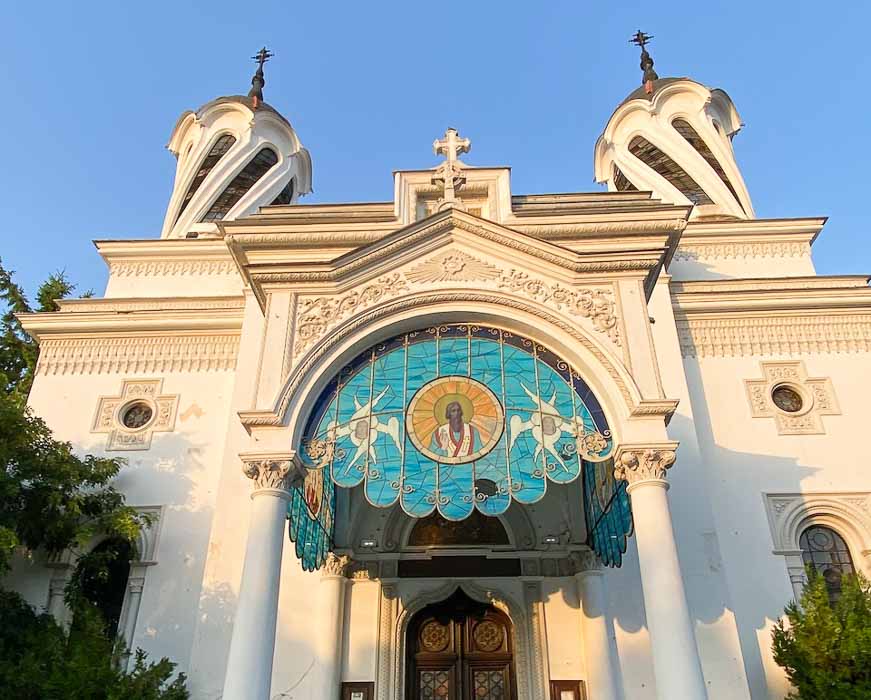
So no matter of your religious beliefs or reasons for visiting Romania, you’ll surely appreciate the art and architecture of these religious edifices.
The 15 Most Beautiful Churches, Monasteries and Cathedrals in Romania
Through their great historic, cultural, and spiritual value, Romanian churches are some of the country’s most treasured monuments. Here’s a list of some of the finest cathedrals, monasteries and churches in Romania.
Romania’s Most Beautiful Cathedrals
Timisoara Orthodox Cathedral
The towering Metropolitan Cathedral has always been an iconic landmark in Timisoara. With its three front towers and a large spire behind, the cathedral looks more like a fairy-tale castle. The building has a total of 11 towers, with the largest reaching over 262 feet (80 meters) in height.
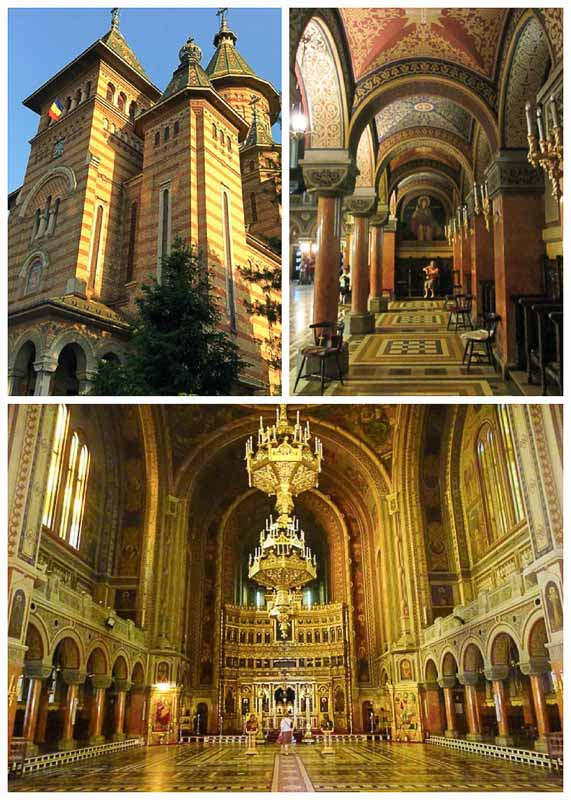
The church’s mosaic tiled roof with splashes of green, red and gold, as well as the commending façade and the elegant interior will surely impress you!
As you enter the church, you’ll find yourself in an enormous nave with high arched ceilings, adorned with gold and azure motifs. The grandeur of this cathedral is a magnificent sight to behold. Truly one of the most beautiful religious edifices in all of Romania!
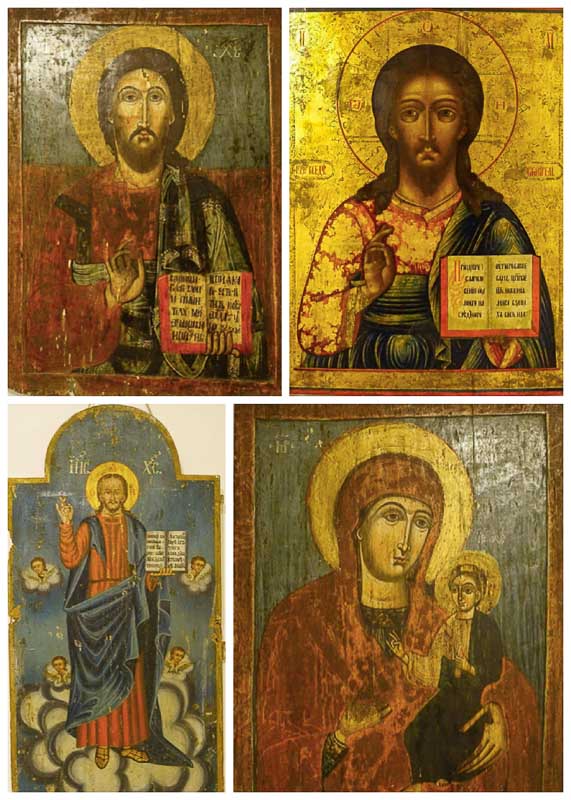
Don’t miss the museum downstairs, in the cathedral basement. Here you’ll see a large collection of religious icons depicting the Orthodox saints, as well as some ancient manuscripts.
The Black Church in Brasov
Stretching high above the sea of orange roofs, the impressive Black Church in Brasov is one of the most beautiful Gothic monuments in Romania. Its imposing structure and grandiose nave makes it the most visited landmark of the city.
Built by the Saxons in the 14th century, the church’s initial name was the Great Church. But after a devastating fire that turned it black in the 17 century, the church became known as the Black Church.
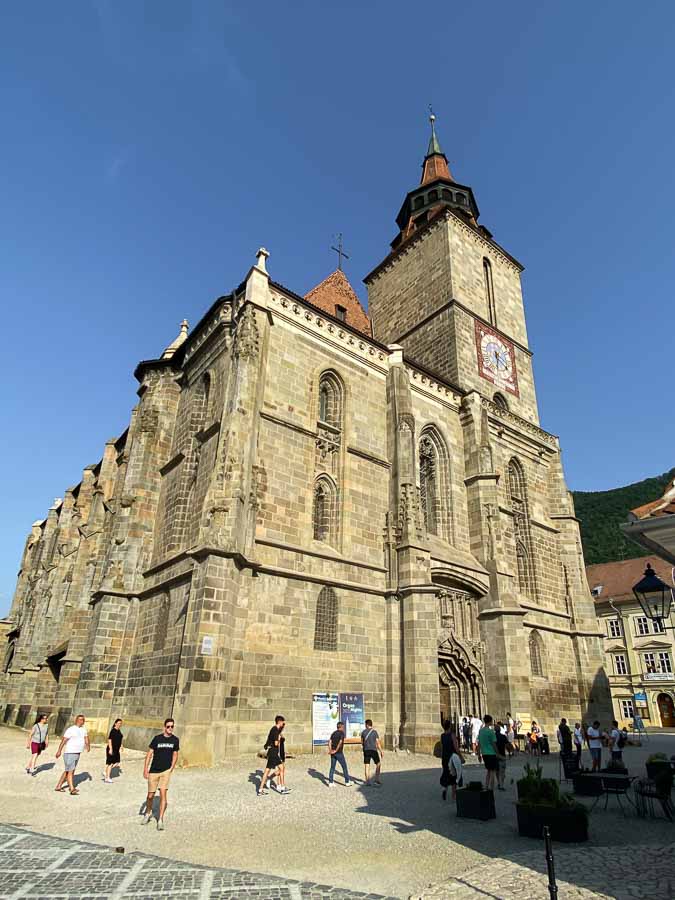
Inside the church there are some beautiful sculptures, the oldest of them being the bust of Saint John the Baptist. Also, don’t miss the gorgeous Anatolian rugs draped across the pews.
The gigantic 4,000-pipe organ, which is one of the biggest in Europe, sounds magnificent! There are recitals here three times a week, so check the schedule if you want to hear its sound.
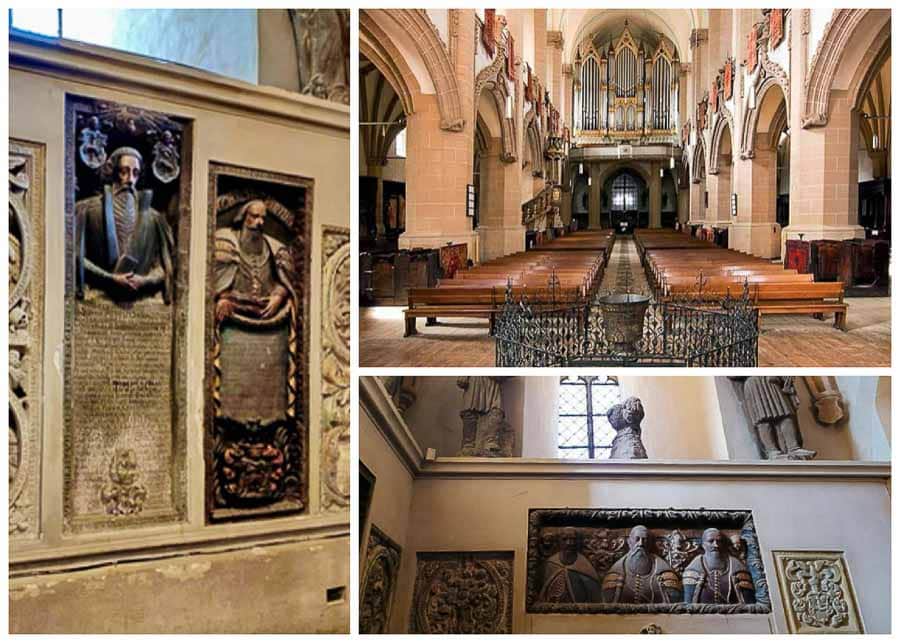
The outside of the church is just as intriguing as the interior. The Black Church has a six-ton bell, which is the largest in all of Romania.
Also outside the church is imposing bronze statue of Johannes Honterus, the theologian who helped spread Lutheranism throughout Transylvania.
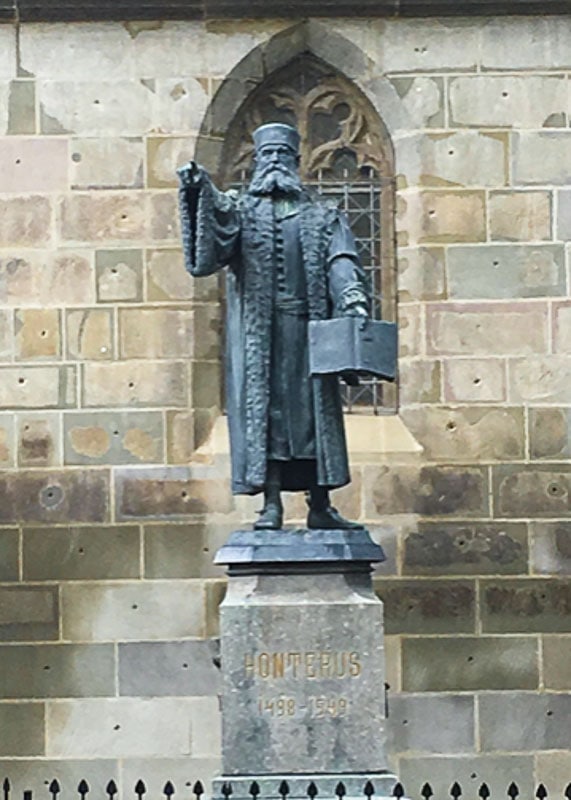
Curtea de Arges Cathedral
Founded in 1514 by Prince Neagoe Basarab, Curtea de Arges Cathedral is one of the most beautiful churches in Southern Romania. The building which resembles a large and elaborate mausoleum in Byzantine style, with Moorish arabesques. Neagoe Basarab did not spare any expense, using a lot of expensive and rare materials in the construction.
The cathedral is oblong in shape, with a central dome fronted by two smaller cupolas and a secondary dome that springs from the annex.
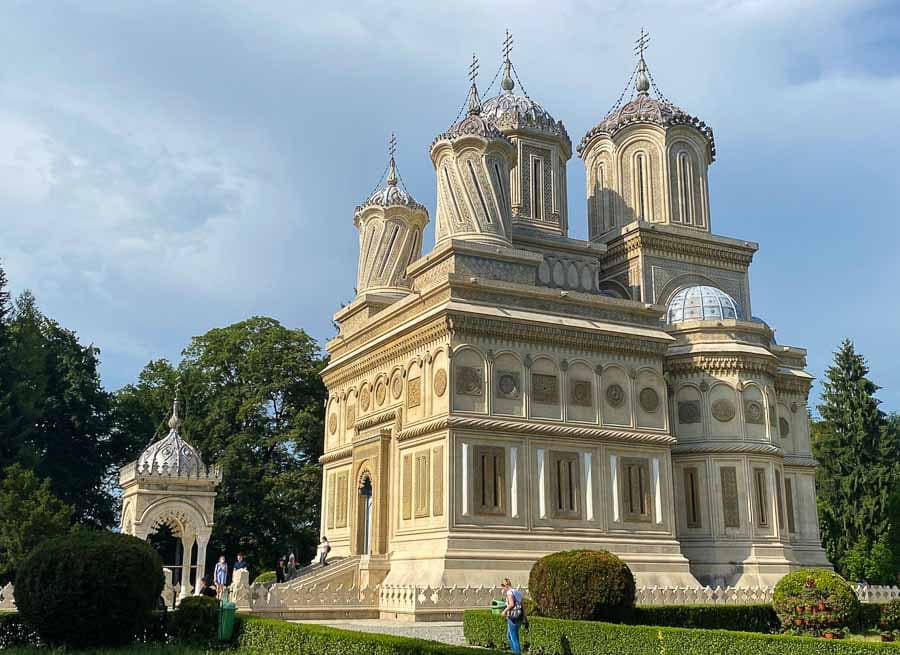
Over the centuries Curtea de Arges Cathedral suffered a series of fires, earthquakes and attacks that left it seriously damaged. Princes Matei Basarab and Serban Cantacuzino restored it partially, but it was Carol I of Hohenzollern-Sigmaringen – the first king of Romania – who completed the renovation work.
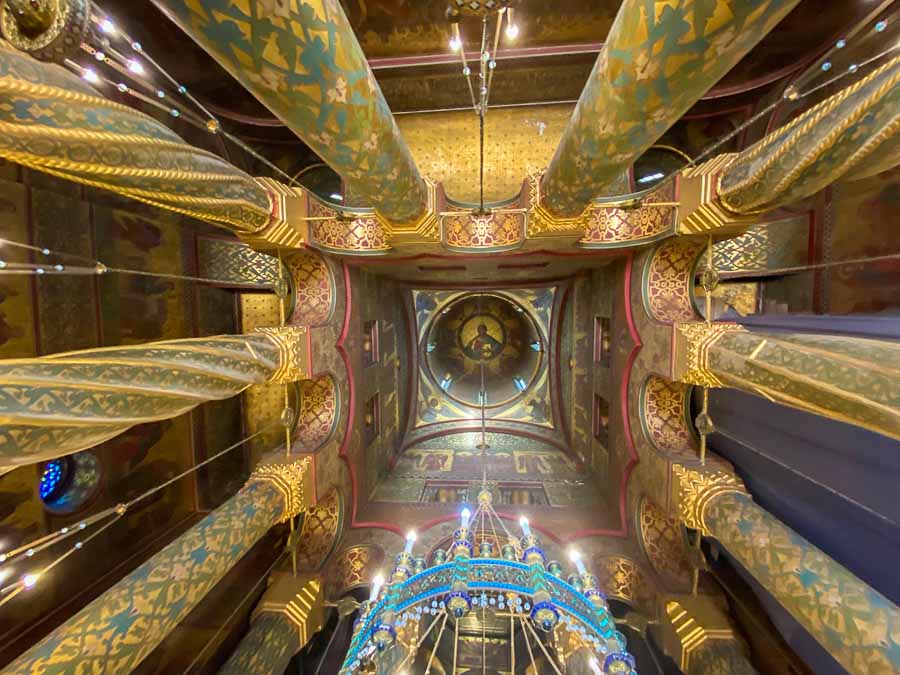
Curtea de Arges is not only a beautiful cathedral, but above all it’s the final resting places of the royal family and of many medieval princes who fought for the independence of Romania.
St.Michael’s Cathedral in Alba Iulia
Sitting on the ruins of a Romanesque church, right in the middle of the Alba Iulia Citadel, you’ll find the St. Michael’s Catholic Cathedral which dates back to the 11th century. This is one of the best-preserved medieval cathedrals in Europe and the oldest church in Romania.
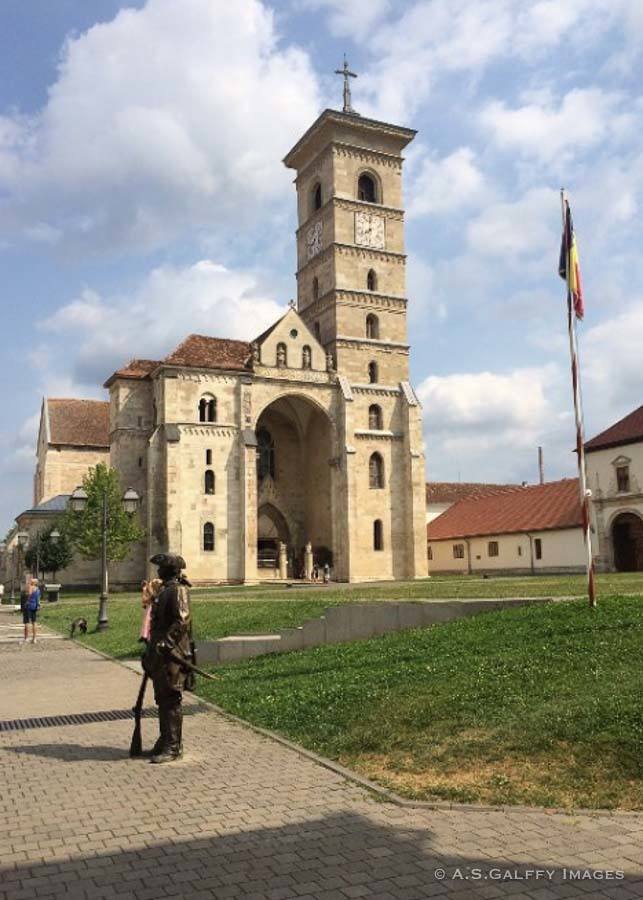
The cathedral is rather small by the European standards, but truly beautiful. The main sanctuary has been subject to several changes and additions, which is why today it looks quite different from its original form.
On the lateral walls are two Romanesque bas-reliefs representing Saint Michael the Archangel. Noteworthy are the altar piece and the pews of the clergy, both of them decorated in Baroque style. The backs of these pews depict scenes from the lives of the prophets and the history of Salvation.
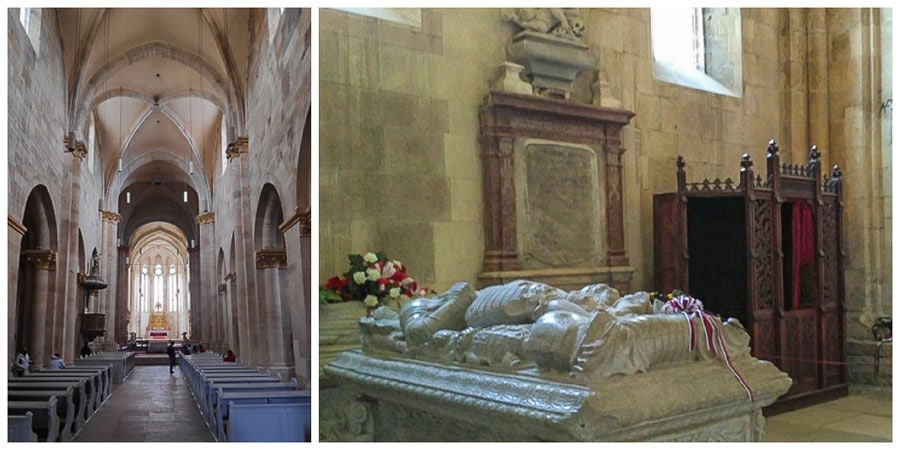
The southern side of the nave shelters the sarcophagus of Janos Hunyadi (aka Iancu de Hunedoara), Voivode of Transylvania and Governor of Hungary.
Most Beautiful Painted Monasteries
The historic region of Bucovina in northern Romania is famous its great collection of painted monasteries. There are eight churches in Bucovina on the UNESCO Heritage list. But out of them there are a few that stand out for their amazing artwork and abounding Byzantine frescos depicting saints, sinners and biblical scenes.
Voronet Monastery
The most famous of these monasteries is Voronet – the crown jewel of Romania’s painted churches. The Monastery was erected in 1488 at the request of Stephen III of Moldavia (aka Stephen the Great), to celebrate the banishing of the Turks from Walachia.
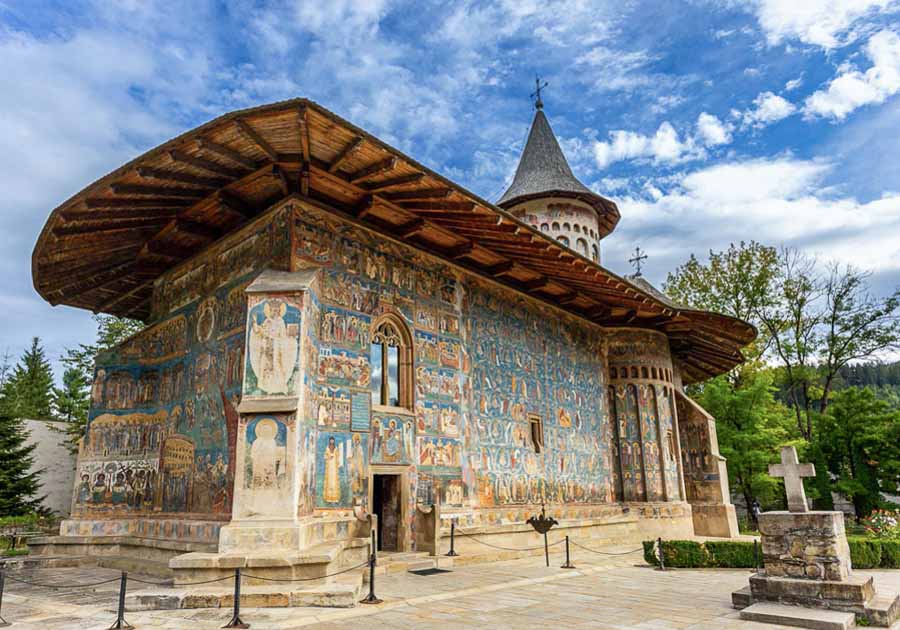
The colorful frescos feature the philosophers Aristotle and Plato, as well as the apostles and the evangelists. Particularly famous is the Last Judgment fresco, painted on the western façade. The fresco depicts Jesus at the top of this scene, from where he judges all of humanity. On the left are the righteous men and women who will go to heaven. On the right, a river of fire takes the sinners to hell.
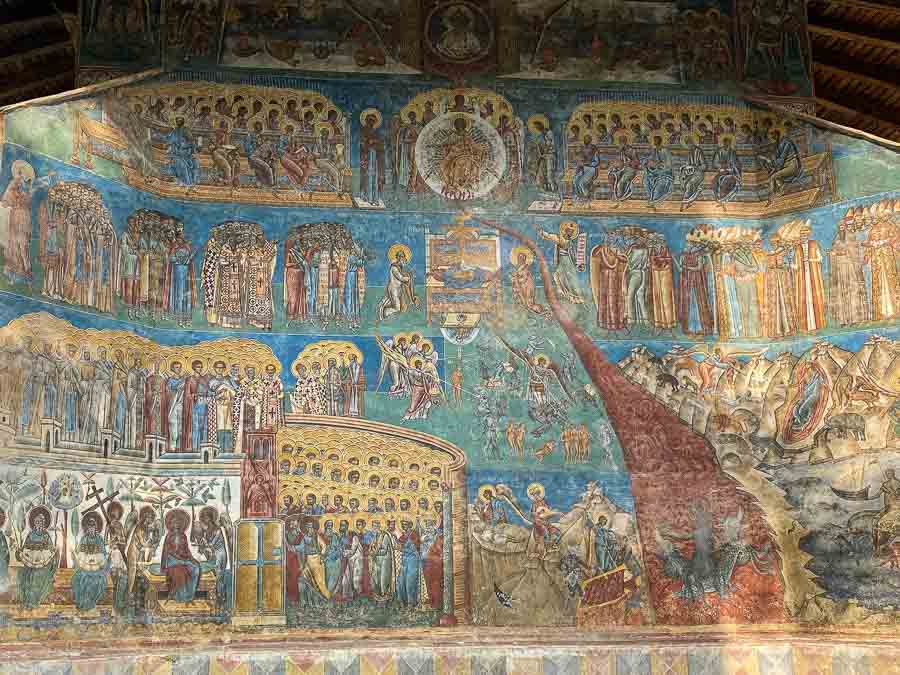
The blue paint, which is the predominant color of the church, has miraculously never faded. So what’s the secret behind the Voronet Blue? Nobody knows. As it appears, the craftsmen guarded their trade secrets fiercely. Therefore, to this day the composition of the paint still remains a mystery.
Moldovita Monastery
Another stunningly beautiful monastery in Bucovina is Moldovita, erected in 1537 by Petru Rares – the illegitimate son of Stephen the Great. Moldovita Monastery is actually a fortress with strong thick walls and watch towers on both corners of the façade and at the gate.
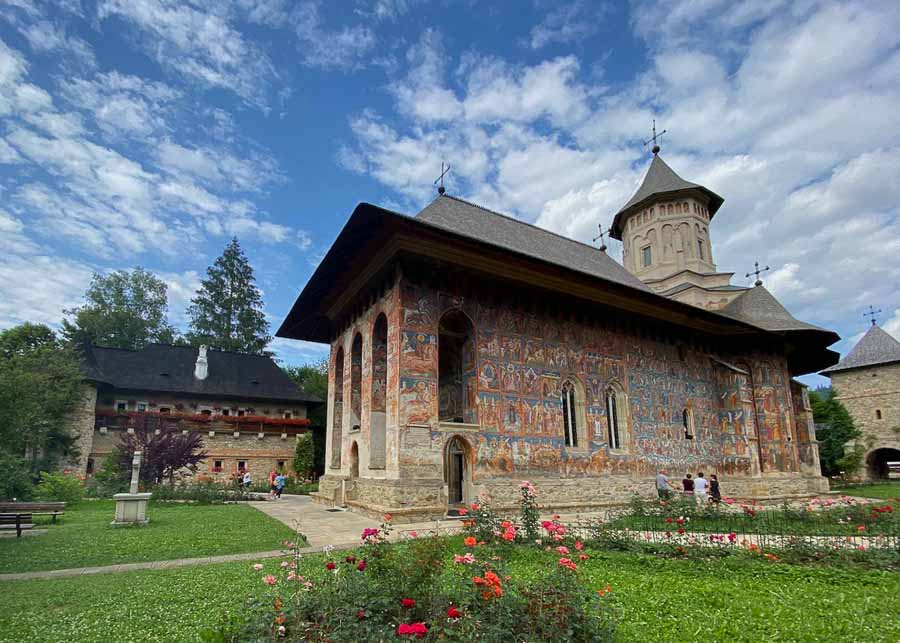
Of all the painted monasteries, Moldovita was my favorite place to visit. Its elegant silhouette standing proud in a lush flower garden is a real feast for the eye!
The exterior walls depict scenes from the Siege of Constantinople and the Last Judgement. The frescos are are still in an excellent shape, with vivid blues and flashes of gold. The richness of the figurative and decorative elements is absolutely impressive.
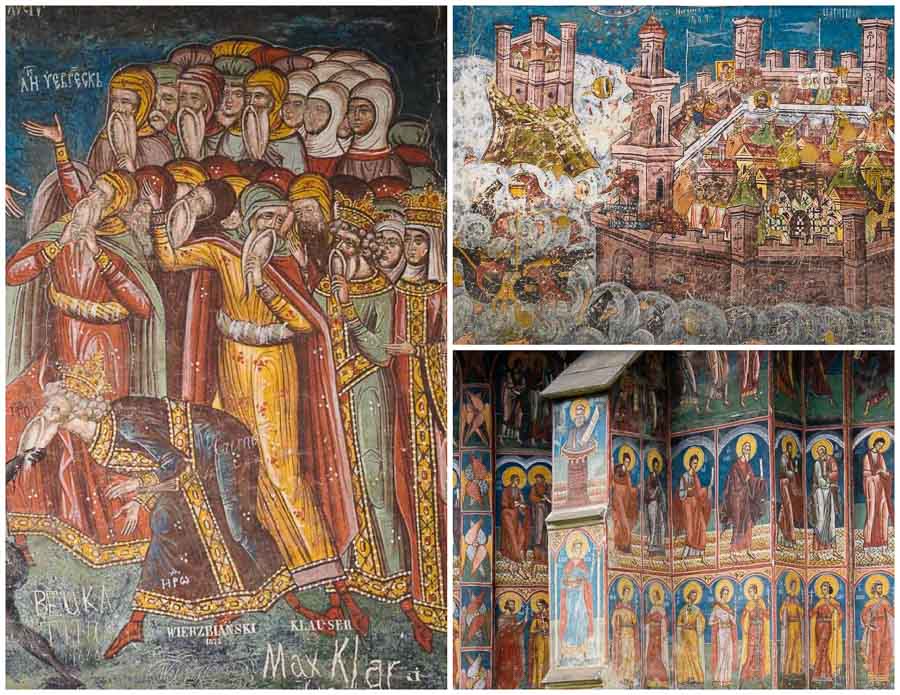
In the northwest corner of the compound is a two-story building, which was the treasury house. Now the building is the monastery museum which houses a collection of embroideries, icons, and liturgical books.
Sucevita Monastery
Sucevita Monastery was built in 1585 by the Movilā brothers, the grandsons of Petru Rares. The exterior walls depict scenes from both the Old and the New Testament. The interior walls feature some magnificent murals that make Sucevita unmissable for historians and art appreciators alike.
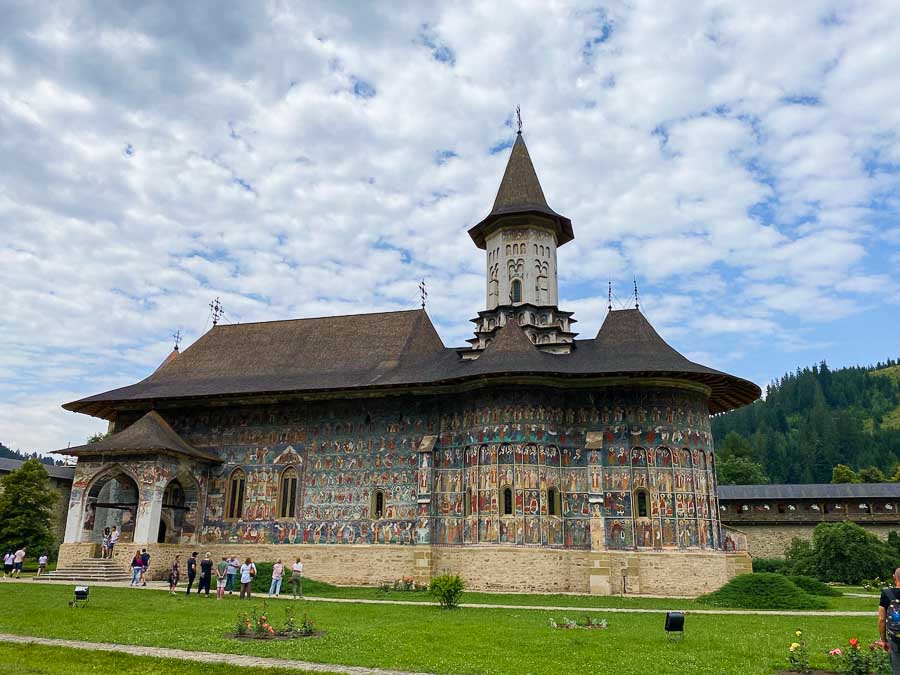
The façade of the church is simple, without any rows of recesses like the other painted churches. The founders probably wanted to have large spaces for the frescoes and left the church with a simple architecture.
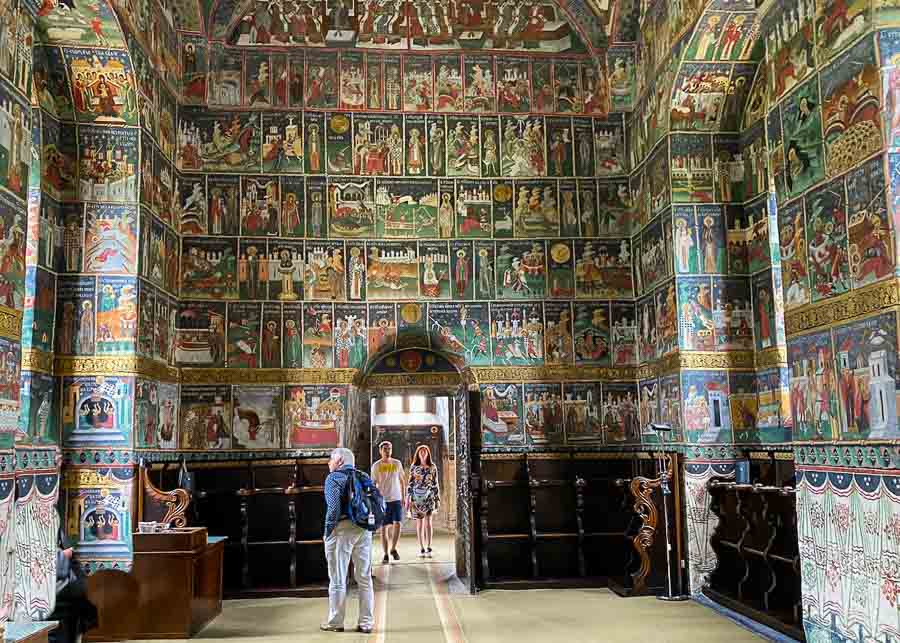
Inside the church, the frescoes show a subtle play between the abundance of gold and the wide range of colors. You see more shades of green than blue here, as opposed to Voronet and Moldovita.
READ NEXT: The Eggs Museum, Bucovina – at the Crossroads of Art and Tradition
Putna Monastery
Located near the city of Suceava, Putna is undoubtedly the most important monastery in Bucovina. Putna was one of the first monasteries built (1466) by Stephen the Great, the famous Moldavian ruler that Romanians hold so dear to their heart.
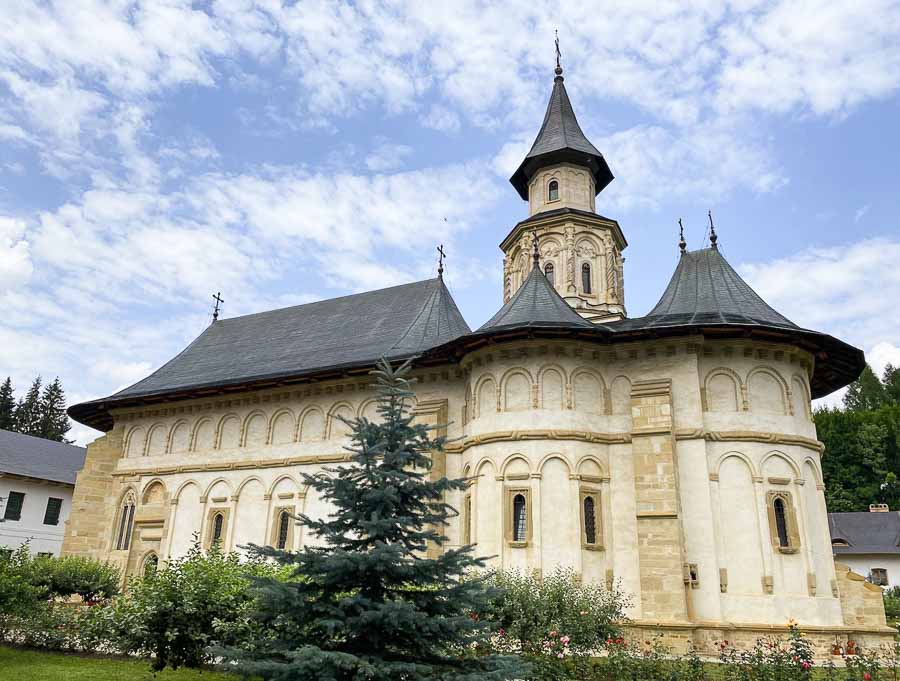
Legend has it that Stephen chose the construction site by shooting an arrow at a nearby hill. The monastery was erected on the ground where the arrow landed.
Putna may lack exterior impressive frescos, but the interior ones are just as beautiful as the ones at Voronet, Sucevita and Moldovita. Also, Putna Monastery is the resting place of Stephen the Great, his second and third wives, and their children.
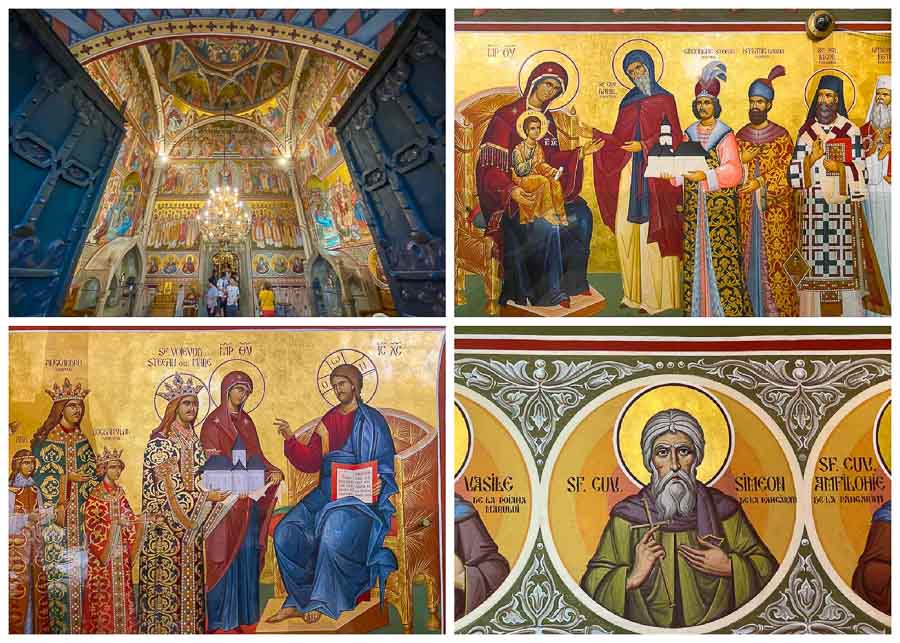
Behind the monastery there is a museum that houses a large collection of medieval objects and manuscripts, among which is the Holy Book that Stephen carried in battle.
Most Beautiful Fortified Churches
The spiritual and defensive center of each village in Transylvania was a fortified church where the villagers would retreat with their belongings in case of an attack. Romania is home to some very beautiful such fortress/churches, seven of which are UNESCO World Heritage sites. Three of the most remarkable ones are in Biertan, Viscri and Prejmer.
Biertan Fortified Church
When you look at the fortified church in Biertan you realize how skillfully the Saxons were in transforming their churches into real fortresses. They surrounded them with several layers of walls which made it really difficult (if not impossible) for the enemy to penetrate.
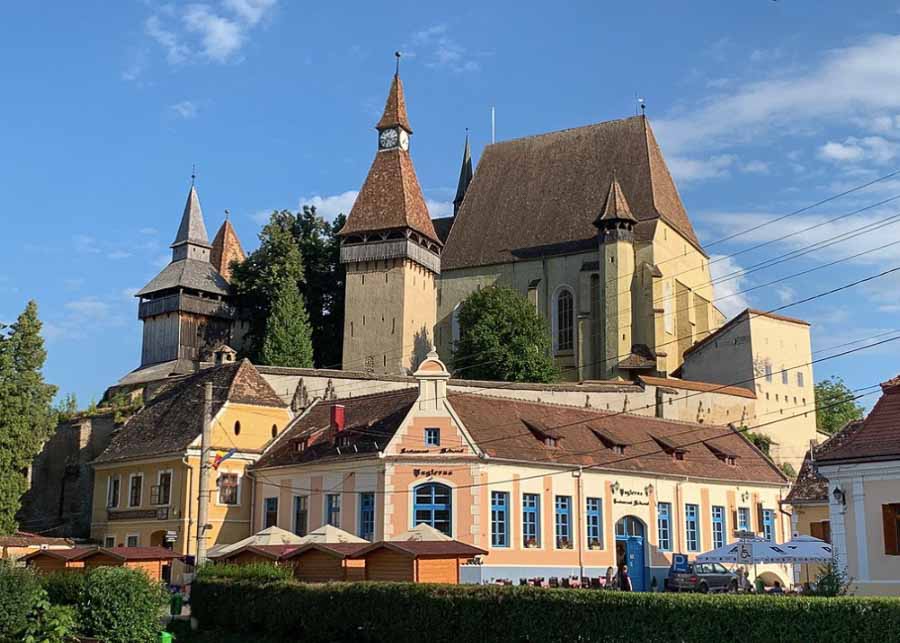
Dedicated to the Virgin Mary, the church in Biertan was built in the 16th century in Gothic style, on the site of an earlier Romanesque church. This was one of the strongest fortified churches in Transylvania.
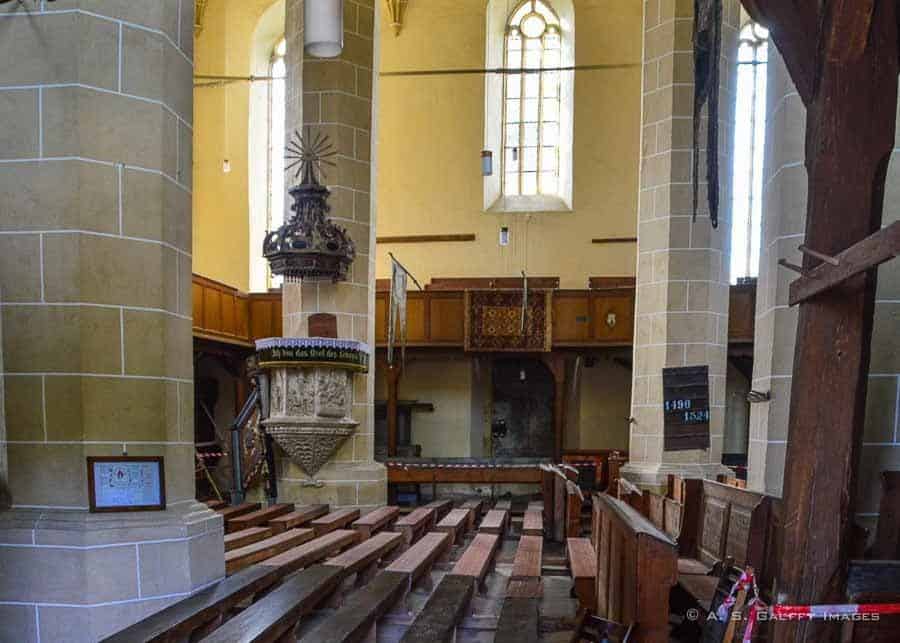
The current hall-church has three naves and retains a design very close to the original. You can still see many of the original elements, including some frescos, the painted pews, the southern tower, as well as the tombstones of the Saxon bishops in the Mausoleum tower.
Also, don’t miss the spectacular altarpiece with twenty-eight icons, which was painted by a Viennese artist in the year 1483.
Viscri Fortified Church
The white church in Viscri village is a modest house of worship in comparison with the church in Biertan, but the fortress itself is equally impressive.
The first church built here dates back to 1100, but that was torn down by Tartars in the mid-13th century. Since the the invasions did not stop after the church was rebuilt, the villages expanded and fortified it to help keep the enemy out.
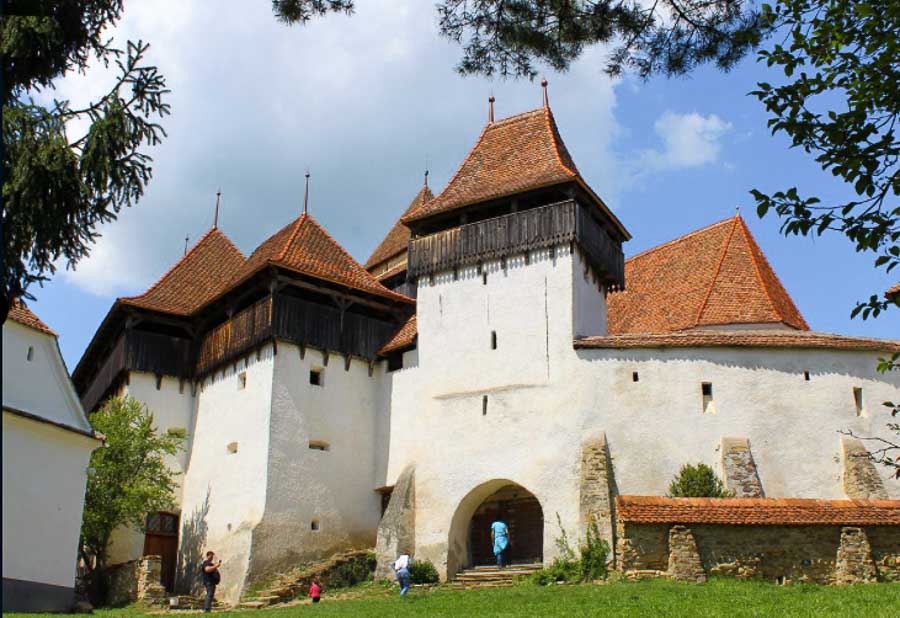
The first outer walls were 23 feet high, allowing people to move safely around the church grounds during wartime. Towers and bastions were added in the 14th century, and a second layer of walls a few hundred years later.
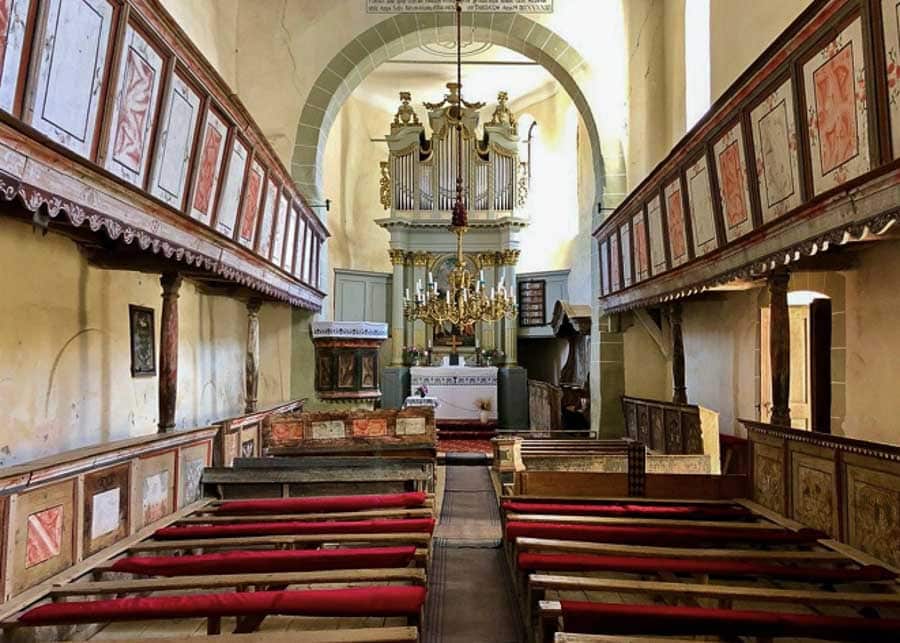
The interior of the church still preserves the paneled ceiling from 1743 and the sober furnishing.
Prejmer Fortified Church
Built by the Teutonic Knights in 1212-1213, Prejmer is the largest fortified church in southeastern Europe. Unlike the fortified church of Biertan, which sits up on a knoll, Prejmer is located right in the middle of the village on a flat terrain.
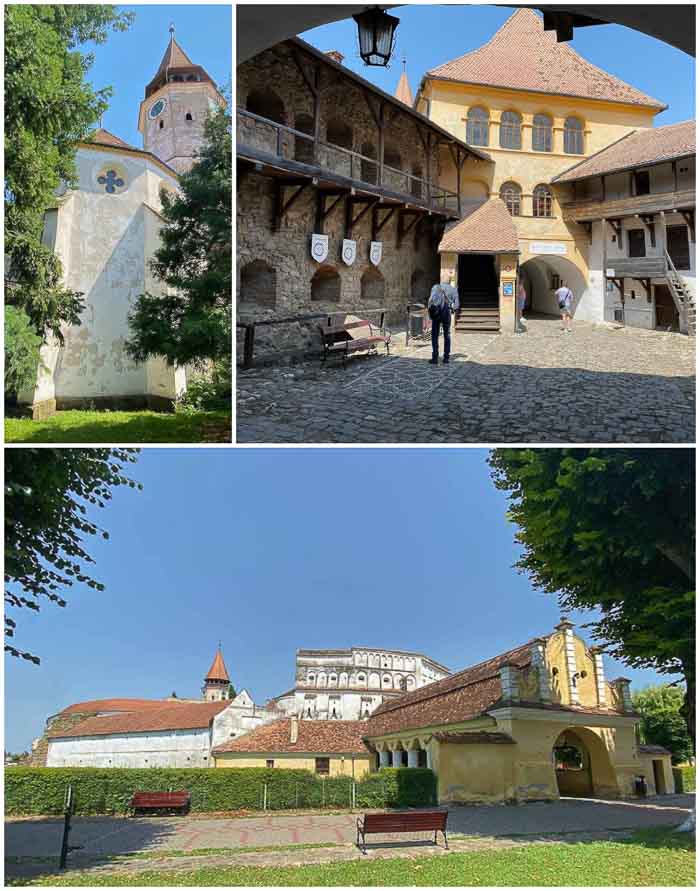
The oval-shaped courtyard is protected by 40-feet high / 12-feet thick defensive walls. Around the walls is an 18-feet deep water ditch. During its 500 years of existence, the fortress was besieged 50 times, but was captured only once.
Most Beautiful Churches in Bucharest, Romania’s Capital
Visiting old churches may not be the first thing that comes to mind when you think of places to visit in Bucharest. But many of these regions monuments are well worth your time even if you’re not a religious person.
Stavropoleos Church
The lovely Stavropoleos Church is probably the most visited church in Bucharest. One of the reason is that it sits right next to Caru’ cu Bere – a very popular restaurant in Old Town Bucharest. But it’s not only the church’s location that makes it well-liked. Stavropoleos church is truly beautiful – a splendid 18th-century monument that was originally part of a Greek monastery.
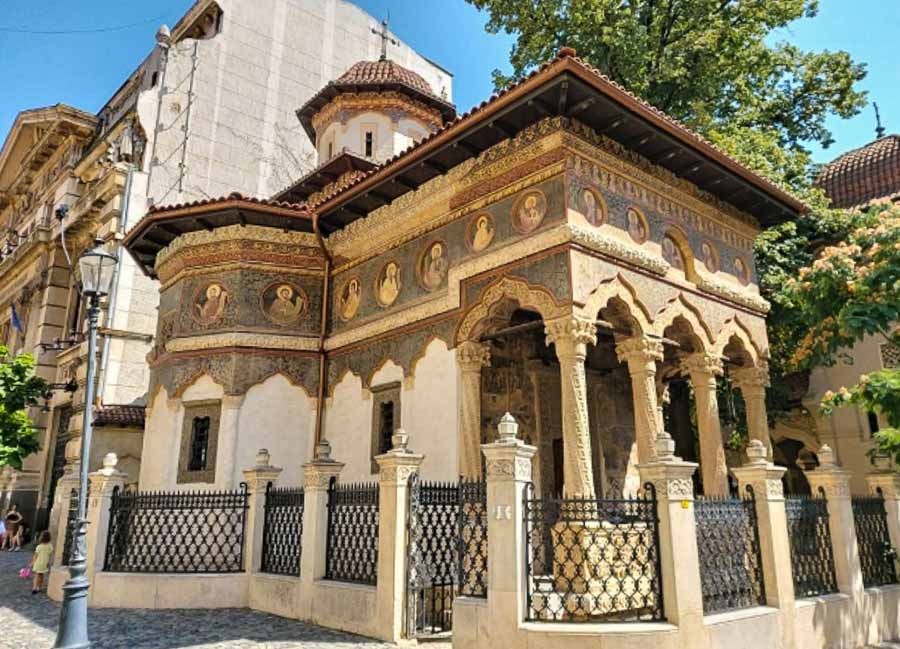
At some point, Stavropoleos Monastery was one of the richest in Bucharest, but during the 19th century a series of fires and earthquakes contributed to its decay.
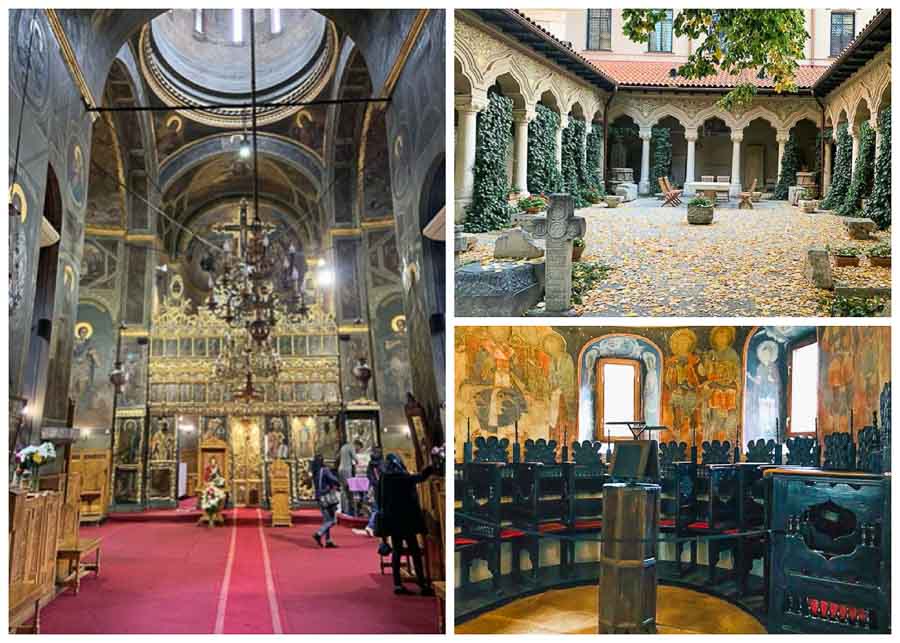
The church you see today is a restoration that was done in the early 20th century by Ion Mincu, one of the most famous Romanian architects.
The small court of the monastery is now an open-air museum which houses a collection of stone crosses and remnants of church buildings that no longer exist in Bucharest.
Kretzulescu Church
Small but adorable, built in a Brâncovenesc style, the Kretzulescu Church is one of the most eye-catching temples in Bucharest.
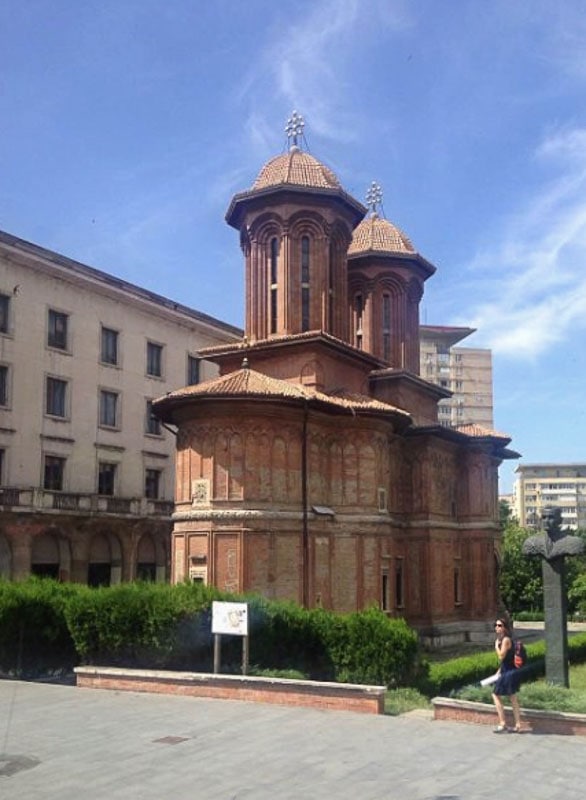
Originally the exterior of the church was painted, but after the restoration of 1935 the façade was made of brick. The only frescos that remained are the ones on the porch.
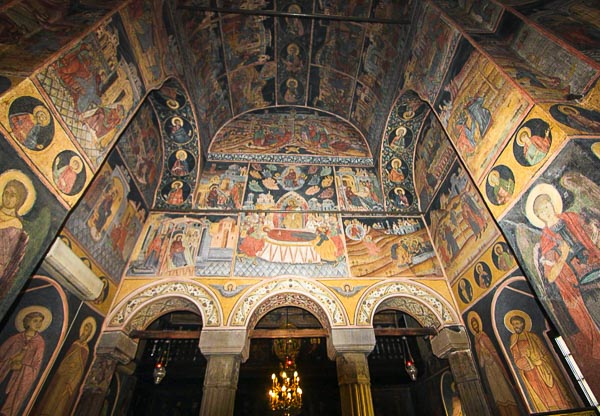
Inside, you’ll see a strikingly-decorated nave with a golden altar and incredible paintings.
Antim Monastery
Tucked away between large, new buildings, the lovely Antim Monastery is one the most beautiful churches in Romania’s capital. The monastery was built at the beginning of the 18th century by Antim Ivireanu, a bishop from Georgia.
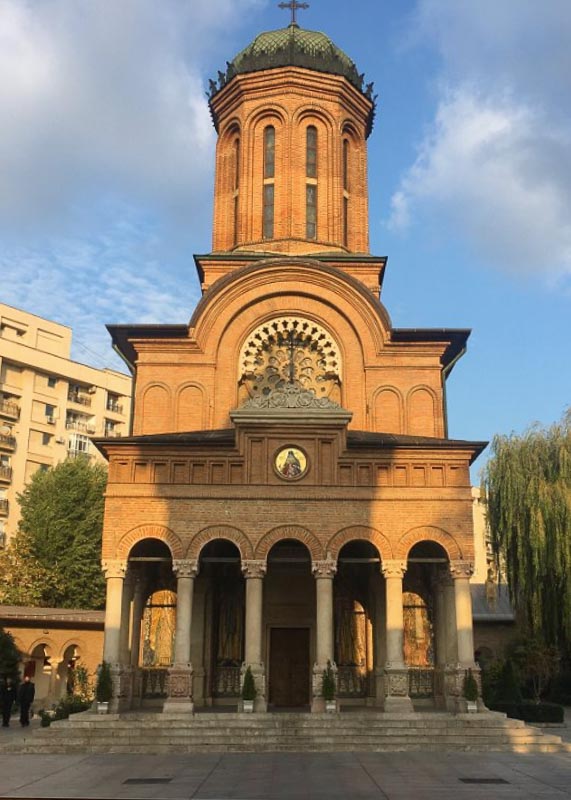
The Antim Monastery had its fair share of misfortunes, but managed to survive the time. It fell into ruin after an earthquake in 1836 and barely escaped demolition during the communist regime, in the 80s. In order to be saved, the whole monastery complex had to be relocated.
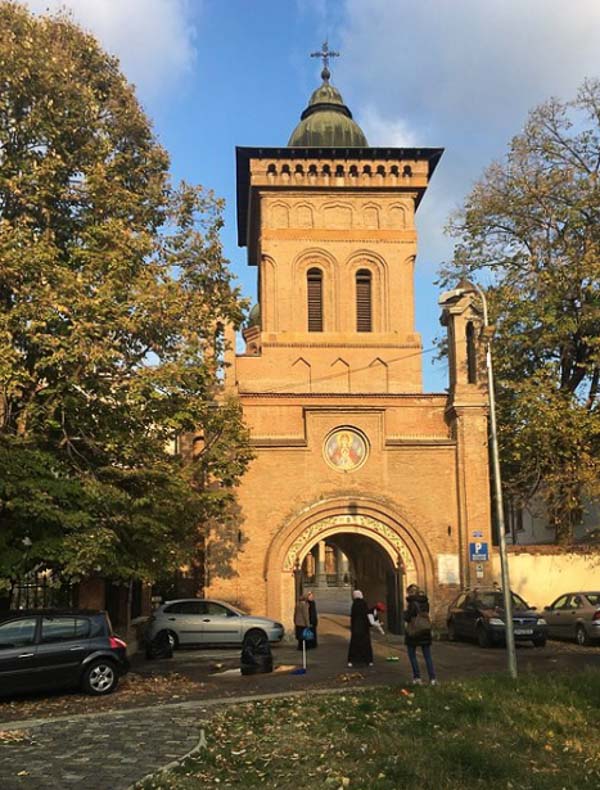
The complex has imposing fortress walls, a large courtyard and a beautiful bell tower that marks today’s entrance. The tower displays gorgeous frescoes dating back to 1857. The church façade is also very pleasing, with large columns and golden ornamentation.
Stepping in, you’ll notice sumptuous icons and frescos depicting scenes from the nativity and the Revelation.
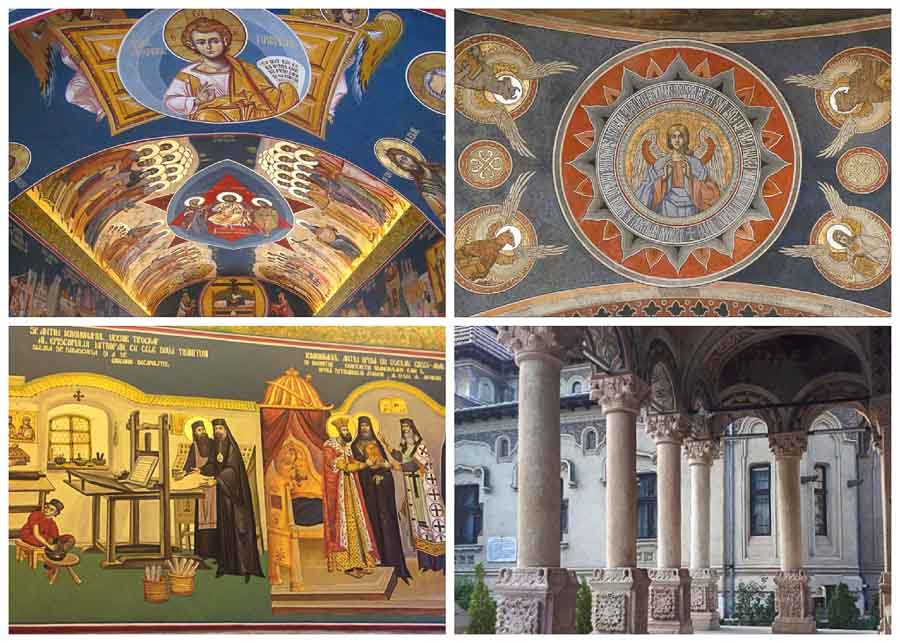
This majestic church was the first public library in Bucharest and had several printing establishments and schools over the years.
St. Nicholas Russian Church
The last but not least of the beautiful churches in Romania is the glittering St. Nicholas Church (a.k.a. the Russian Church) in Bucharest. Located just off University Square, the church was built in 1905 for the Russian Consulate employees as well as for the Russian community of Bucharest. Tzar Nikolai II himself provided the funds for the construction (600,000 gold rubles).
The brick and stone building has seven domes in the shape of an onion, which are very characteristic of Russia, but quite unusual in Romania. The domes were initially covered in gold.
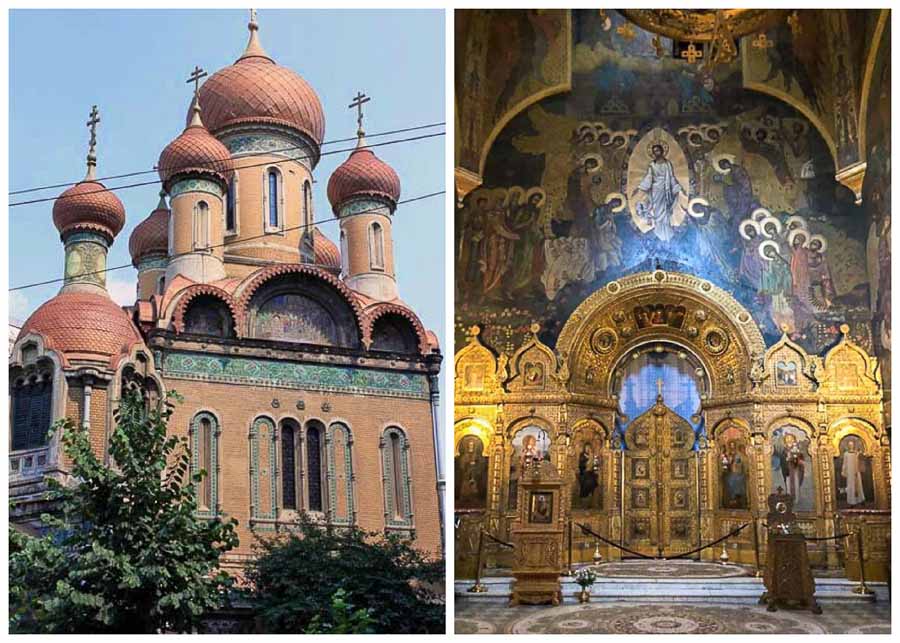
In the 1st World War the church suffered severe damages, but the Russian community in Bucharest gathered funds and repaired it after the war.
During the interwar period St. Nicholas Church passed back and forth from Russian to Romanian jurisdiction. In 1992 the Romanian Orthodox Church finally regained control over the church and attributed it to the students, given its proximity to the University of Bucharest.
A Final Word
Romania has a great deal of beautiful churches and monasteries scattered throughout its territory. The characteristics of each region is reflected in the architectural style of the churches, which means you’ll be seeing a great diversity of religious edifices. For me it’s always a joy to stumble upon a new little church hidden somewhere in a village, or in the least expected place in Bucharest.
If you’re interested in finding out more about the Romanian churches and monasteries, you can book a dedicated tour, such as the Bucovina Monasteries Tour, or the Fortified Churches Tour. Or you can choose a Private Walking Tour of Old Town Bucharest that will take you to some of these hidden churches in Bucharest.
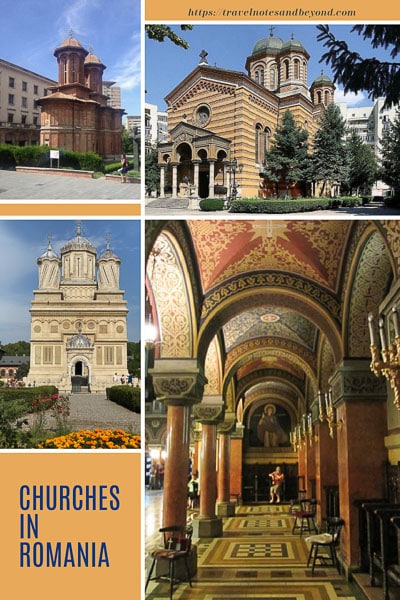

 The Transfagarasan – How to Tackle Romania’s Epic Highway
The Transfagarasan – How to Tackle Romania’s Epic Highway



Virgikiu
Unfortunately you do tell nothing about the chources and monasteries from Iași
Anda
Sadly I haven’t visited those churches yet, but once I do I will update my post.
Saurabh
WOW. Romania has so many beautiful churches. Romania is definitely on my bucket list. For me visiting a religious site is all about exploring the architecture and the culture.
Subhashish Roy
I would probably visit Romania because of the Churches and of course everything else that follows. I love visiting Churches and Cathedrals because of their fascinating history. I am not a strict believer of the religion but have close connections with Churches right from childhood days.
Trisha Velarmino
I did not know that Romania has this number of worship places. In my culture, we have this belief that if it is our first time to visit a holy place, we can make a wish and it will come true. I’d definitely be making plenty of wishes here in Romania if I get the chance to visit. Timisoara Cathedral looks heavenly. Curtea de Arges Cathedral has a quaint exterior design.
Anda
Hahaha, you are right: plenty of wishes to be made in Romania!
Bhushavali N
Even though I’m not a Christian, I love visiting historic churches, esp. in Europe. Their architecture, sculptures, frescoes are all so captivating. Timiosara looks so magnificent – 80m tall tower? Wow! The golden artworks are just gorgeous. 4000 pipe organ? I think I will check its schedule first and then plan the rest of my itinerary when I visit Romania! Haha. Voronet monastery looks absolutely gorgeous. Isn’t the blue Lapis Lazuli like most in most frescoes of that era?
Tami Wilcox
You definitely don’t have to be religious to appreciate what these churches and cathedrals offer. I adore exloring churches for the art and history — plus they’re generally very peaceful places to be. With all the stained glass windows, mosaics, paintings, sculptures, architecture, and more, what’s not to love?
Jan
I love visiting churches and cathedrals to admire their architecture and glasswork. I have not been to Romania yet, but it is in my bucket list. Romania’s churches and architecture look so grand and beautiful. My favorite is Curtea de Arges cathedral. Lovely images too. 🙂
Anda
Thank you, Jan.
Raksha
When I was in Romania last time, I had the chance of visiting only two churches and I must say that I loved them. The history, the wall decor and paintings and the old nature of those churches were breath taking. I do wish I had more time to see and experience the local culture and visiting more churches. I will keep these in mind for my next visit whenever it happens.
Medha Verma
I love visiting churches even though I’m not a religious person because of mostly the architecture. I often tell people that Romania is an underrated destination because I’ve been there and I loved it and I don’t understand why people do not include it in their bucket lists. I have, in fact, been to some of the churches you mention such as the Black Church in Brasov & Viscri Fortified Church. I was a little disappointed that I couldn’t make it to Bucovina because the monasteries there look pretty awesome!
Anda
Maybe you’ll return to Romania someday.
Linda (LD Holland)
We are not religious but that does not stop us from visiting churches everywhere we travel. What a great variety you found in Romania. And some beautiful ones too! The Curtea de Arges definitely is stunning. The painted monasteries look like works of art. We really do need to move Romania up on our travel wish list.
Anda
Absolutely! Romania deserves a higher up place on any bucket list.
Akos+Galfi
Very valuable informations and historical references,
outstanding photos, top Quality présentation of all this treasures !!
Congratulations Anda !!!
Anda
Thank you, Akos. I appreciate it.